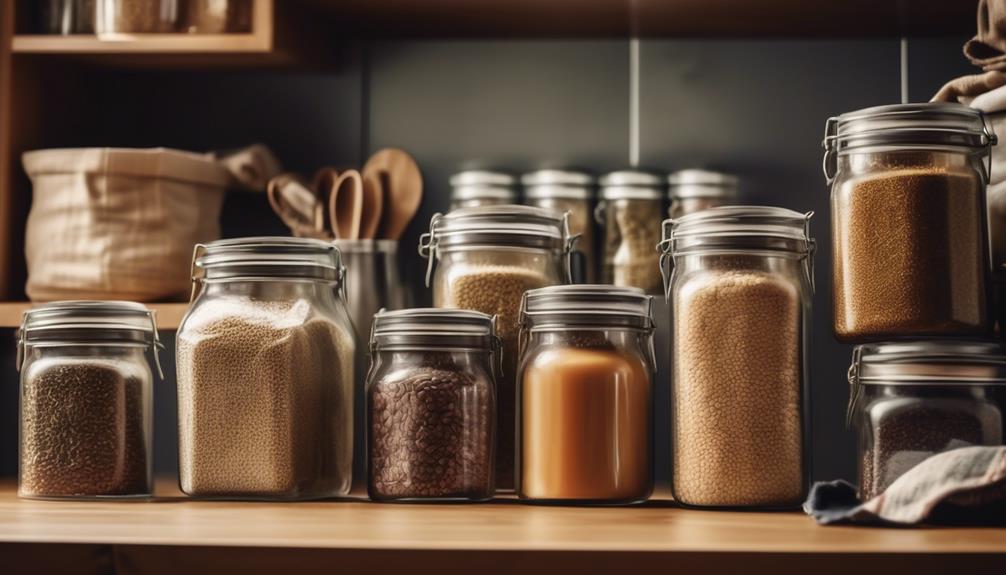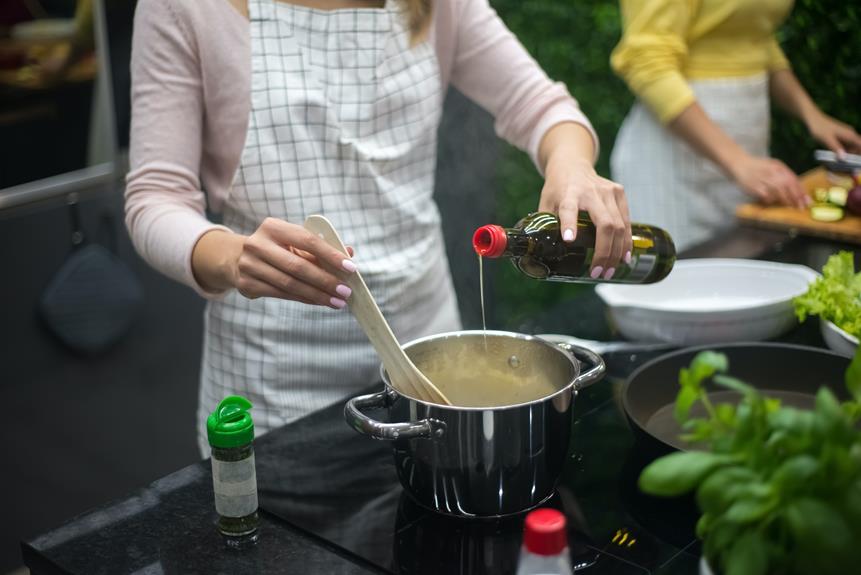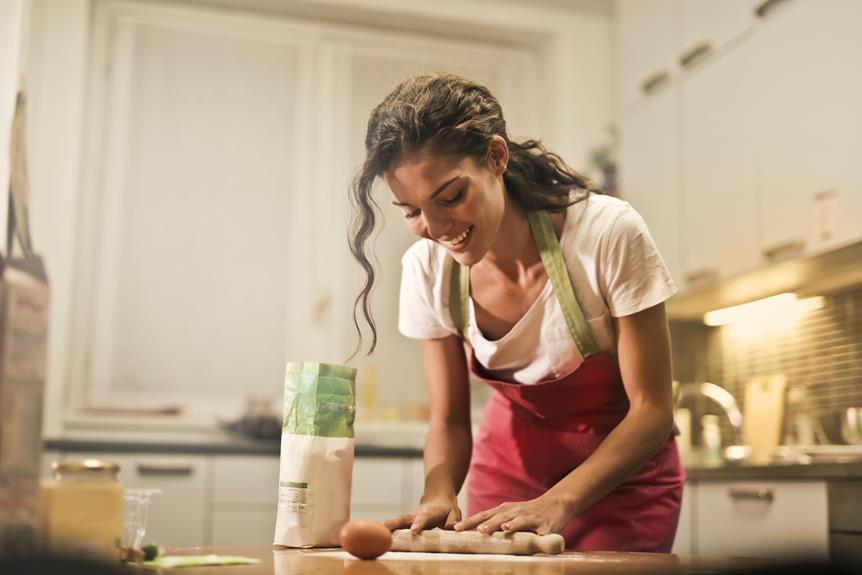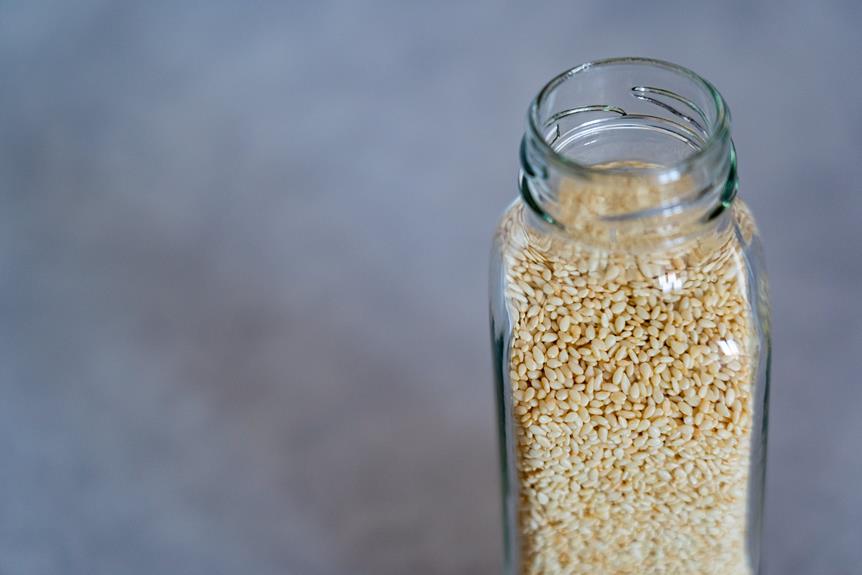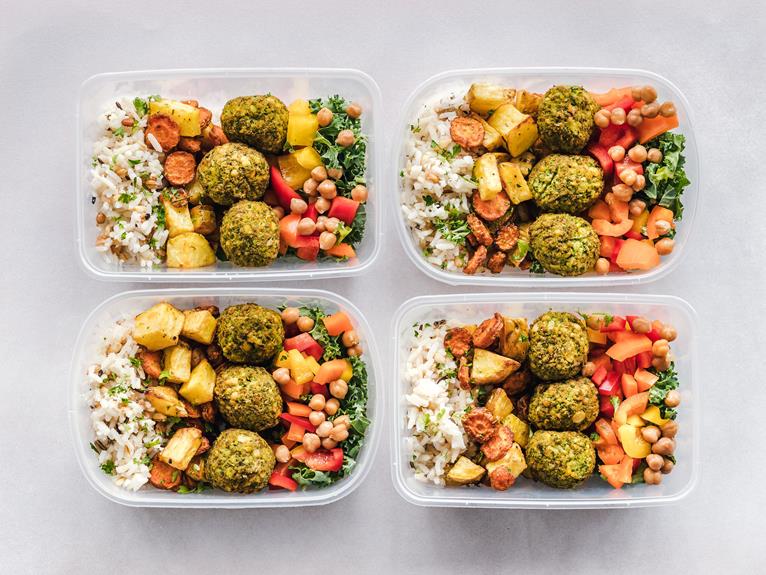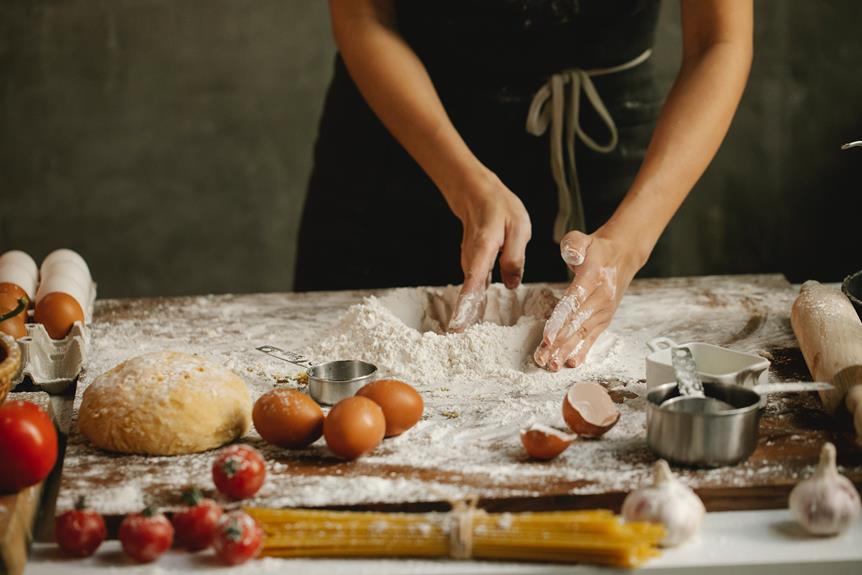As the world grapples with the environmental challenges posed by excessive waste, the zero waste movement has emerged as a powerful solution. In the context of the kitchen, adopting zero-waste practices involves rethinking our approach to food consumption, storage, and disposal.
By embracing a zero-waste lifestyle in the kitchen, individuals can minimize their ecological footprint and contribute to a healthier planet. This article aims to provide insightful tips and strategies for creating a zero-waste kitchen that promotes sustainability and resourcefulness.
Composting Food Scraps
Composting food scraps is a simple and beneficial way to reduce waste and improve the health of your garden or plants. To get started, designate a specific bin or container for collecting your food scraps. This small step can make a big difference.
Instead of sending your food waste to the landfill, where it contributes to harmful greenhouse gas emissions, you can transform it into nutrient-rich compost.
Composting offers a range of benefits for both you and the environment. One of the key advantages is waste reduction. Food scraps make up a significant portion of household trash, and by composting them, you actively participate in efforts to reduce landfill waste. This helps alleviate the strain on landfills and promotes a more sustainable approach to waste management.
In addition, composting enriches the soil by adding essential nutrients and improving its structure. The resulting compost acts as a natural fertilizer, enhancing plant growth and increasing their resilience against pests and diseases. It also helps retain moisture in the soil, reducing the need for excessive watering. By using compost, you can save money that would otherwise be spent on expensive chemical fertilizers.
Composting isn’t only environmentally friendly but also a cost-effective way to maintain a healthy garden and reduce your ecological footprint. So start composting your food scraps today and reap the benefits of a more sustainable and nourishing approach to gardening.
Reusable Produce Bags
Now that you’ve learned about composting food scraps, let’s explore another eco-friendly kitchen tip: using reusable produce bags.
These bags are a great way to reduce waste and have a positive impact on the environment. By using reusable produce bags, you can significantly reduce the number of single-use plastic bags that end up in landfills or polluting our oceans.
Produce bags are used to store fruits and vegetables, keeping them fresh and preventing them from spoiling before you can use them. By storing your produce in reusable bags, you can extend their shelf life and minimize food waste. This not only saves you money but also helps conserve the resources used to produce the food.
Let’s take a closer look at the benefits of using reusable produce bags:
- Environmentally friendly: By choosing reusable bags over single-use plastic bags, you’re making a positive impact on the environment. You’re reducing plastic waste and minimizing the harmful effects on ecosystems.
- Durable and long-lasting: Unlike flimsy plastic bags, reusable produce bags are made from sturdy materials that can withstand regular use. They’re designed to be durable and long-lasting, so you can rely on them for all your produce storage needs.
- Easy to clean: Reusable produce bags are easy to clean, making them convenient to use again and again. Simply toss them in the washing machine or hand wash them, and they’ll be ready for your next grocery trip.
Bulk Buying Essentials
Buying essential items in bulk can save you money and reduce packaging waste in your kitchen. There are several reasons why you should consider this approach:
- Save money: Buying in bulk allows you to get larger quantities of grains, beans, and spices at a lower cost per unit. This can lead to significant savings, especially for items you use frequently in your cooking.
- Reduce packaging waste: Purchasing in bulk helps minimize packaging waste in your kitchen. Instead of multiple smaller packages, you can buy larger quantities that come in minimal or reusable packaging. This not only reduces waste but also promotes a more sustainable lifestyle.
- Customize quantities: Buying in bulk gives you the flexibility to choose the right quantity for your needs. Whether you need a small amount for a recipe or prefer to stock up on essentials, bulk buying allows you to customize your purchase without unnecessary packaging.
- Support local businesses: Many bulk food stores and co-ops prioritize sourcing products locally. By buying in bulk, you can support these local businesses and contribute to a sense of community. Additionally, purchasing from local suppliers often means fresher and higher quality products.
Meal Planning and Portion Control
Creating a zero-waste kitchen involves careful meal planning and portion control. By incorporating meal prep and portion size control into your routine, you can’t only reduce food waste but also save money and time.
Meal planning requires thinking ahead and deciding what to cook for the week, while portion control ensures that you’re only cooking and consuming what you need.
To start meal planning, set aside some time each week to plan out your meals. Take inventory of the ingredients you already have and make a list of what you need to buy. By planning your meals in advance, you can avoid unnecessary purchases and minimize the chances of food going to waste. Additionally, meal planning allows you to make healthier choices and avoid last-minute takeout or convenience foods.
When it comes to portion control, it’s important to be mindful of how much food you’re preparing and consuming. It’s easy to get carried away and cook more than necessary, which leads to food waste. Familiarize yourself with appropriate portion sizes for different food groups and adjust your cooking accordingly. If you find yourself with leftovers, get creative and repurpose them into new dishes instead of letting them go to waste.
Using Beeswax Wraps
If you want to reduce waste in your kitchen, consider using beeswax wraps as a sustainable alternative to plastic wrap. Beeswax wraps are made from cotton fabric that’s coated in a mixture of beeswax, jojoba oil, and tree resin. They offer several benefits and are a great way to minimize your environmental impact.
Here’s why you should consider incorporating beeswax wraps into your kitchen routine:
- Environmentally Friendly: Beeswax wraps aren’t only reusable but also biodegradable, making them an excellent choice instead of single-use plastic wrap. By using beeswax wraps, you can significantly reduce your plastic waste and contribute to a healthier planet.
- Versatile: Beeswax wraps can be used in various ways, such as covering containers, wrapping sandwiches, fruits, and vegetables, or even molding around bowls. They’re flexible and can easily adapt to different shapes and sizes. Say goodbye to plastic wrap that only works for specific containers!
- Natural and Safe: Unlike plastic wrap, beeswax wraps don’t contain harmful chemicals that can seep into your food. The beeswax and jojoba oil used in the wraps have natural antibacterial properties, helping to keep your food fresh for longer.
- Easy to Clean and Maintain: Beeswax wraps can be washed with mild soap and cold water, and they air dry quickly. With proper care, beeswax wraps can last up to a year, saving you money in the long run.
DIY Cleaning Products
Consider making your cleaning products at home for a cost-effective and eco-friendly way to keep your kitchen clean. By using natural disinfectants and eco-friendly detergents, you can reduce waste and harmful chemicals in your kitchen environment.
When it comes to natural disinfectants, vinegar is a versatile and effective option. Mix equal parts vinegar and water in a spray bottle and use it to clean countertops, sinks, and cutting boards. Vinegar’s acidity kills bacteria and germs, leaving your kitchen surfaces clean and safe.
Lemon juice is also a natural disinfectant that can clean and deodorize your kitchen. Simply squeeze fresh lemon juice onto a cloth or sponge and wipe down surfaces for a fresh scent.
For eco-friendly detergents, you can make your dish soap and all-purpose cleaner. Castile soap, made from vegetable oils, is an excellent base for these cleaning products. Mix it with water and a few drops of essential oils for a fresh scent. Use this mixture as a dish soap to effectively remove grease and grime from your dishes.
To make an all-purpose cleaner, mix castile soap with water and vinegar for a powerful cleaning solution that can be used on various surfaces in your kitchen.
Upcycling Food Containers
Let’s explore how you can repurpose your food containers to reduce waste in your kitchen. Instead of throwing away those empty food containers, why not give them a new life? By upcycling them, you can’t only reduce waste but also save money and add a touch of creativity to your kitchen.
Here are four creative food storage ideas using alternative containers:
- Mason jars are versatile glass jars that can be used for storing dry goods like grains, pasta, and nuts. They’re also great for storing homemade sauces, dressings, and pickles. With their transparent design, you can easily see what’s inside, making it convenient to find what you need.
- Don’t discard those plastic yogurt containers just yet! They can be repurposed as small food storage containers for leftovers, snacks, or even makeshift plant pots for growing herbs. Their compact size makes them perfect for packing lunch or storing small quantities of food.
- Ice cream tubs can be transformed into convenient storage containers for bulk items such as rice, flour, or sugar. Simply wash them thoroughly, remove any labels, and use them to store your pantry staples. The best part is that they’re stackable, saving valuable space in your kitchen cabinets.
- Don’t overlook the potential of egg cartons. They can be incredibly useful for organizing and storing small items like spices, jewelry, or office supplies. By cutting off the lid, you create a ready-made organizer with compartments. You can even use them to start seedlings for your garden.
Avoiding Single-Use Plastics
Reduce plastic waste in your kitchen by making simple changes to your daily routine. Avoiding single-use plastics is an important step toward creating a more sustainable and environmentally friendly kitchen. One easy way to do this is by choosing products with plastic-free packaging.
Instead of buying items that come in plastic containers, look for alternatives that use glass, metal, or paper packaging. These materials aren’t only more sustainable, but they can also be recycled or composted.
When grocery shopping, opt for items that are packaged in sustainable alternatives to plastic. Instead of pre-packaged fruits and vegetables, choose loose produce that can go directly into your reusable shopping bag. You can also bring your containers or bags for bulk grains, nuts, and spices, avoiding the need for plastic bags or packaging.
In addition to plastic-free packaging, there are other sustainable alternatives you can incorporate into your kitchen routine. Instead of using plastic wrap or aluminum foil for leftovers, consider using reusable beeswax wraps or silicone food covers. These options aren’t only better for the environment, but they can also save you money in the long run.
Growing Herbs and Vegetables at Home
To make your kitchen more sustainable, start by exploring the benefits of growing herbs and vegetables at home. Indoor gardening not only gives you access to fresh produce whenever you need it, but it also helps reduce your carbon footprint and creates a sense of belonging to a community of environmentally conscious individuals.
Here are four compelling reasons why you should consider starting your indoor garden.
Growing your herbs and vegetables ensures fresher and healthier food. When you have control over the use of pesticides and fertilizers, you can be confident that your produce is free from harmful chemicals. Plus, since there’s no transportation time between the garden and your plate, you can enjoy the freshest and most nutrient-rich food possible.
Indoor gardening allows for space optimization. By utilizing vertical farming techniques, you can make the most of your growing space. Wall-mounted shelves or hanging planters enable plants to grow upwards, saving valuable floor space. This is especially beneficial for those living in small apartments or homes with limited outdoor areas.
In addition to saving space, growing your herbs and vegetables can lead to significant cost savings. The initial investment in seeds, soil, and containers is minimal compared to the long-term savings you’ll enjoy from not having to buy fresh produce regularly. It’s a win-win situation for both your wallet and the environment.
Lastly, indoor gardening promotes a sustainable lifestyle. By reducing packaging waste and the need for long-distance transportation, you align with the zero waste philosophy. Furthermore, nurturing plants indoors fosters a deeper connection with nature and a sense of self-sufficiency. It’s a fulfilling way to embrace a more sustainable lifestyle overall.
Shopping at Farmer’s Markets
Consider exploring the benefits of shopping at local farmer’s markets to support sustainable agriculture and enjoy fresh, organic produce. Shopping at farmer’s markets not only allows you to connect with the local community but also supports local farmers directly.
Here are some shopping tips to make the most out of your farmer’s market experience while supporting sustainable agriculture.
Create a shopping list before you go to the market. This will help you stay focused and avoid making impulse purchases. Plan your meals for the week and write down the ingredients you need. By doing this, you can avoid buying unnecessary items and reduce food waste.
When you arrive at the farmer’s market, take a stroll around to see what’s available before making your purchases. This will allow you to compare prices, quality, and freshness. By supporting local farmers, you aren’t only investing in the local economy but also helping to preserve farmland.
Don’t hesitate to ask questions! Have conversations with the farmers about their growing practices and inquire about pesticide and herbicide use. By supporting organic farming methods, you’re promoting sustainable agriculture and safeguarding the environment.
Bring your reusable shopping bags or baskets to carry your purchases. This reduces the need for single-use plastic bags and helps minimize waste. Additionally, consider bringing cash, as some farmers may not accept card payments.
Reducing Food Waste Through Proper Storage
Properly storing your food can help reduce waste and keep your produce fresh for longer. This not only saves you money but also contributes to a more sustainable and waste-free kitchen. Here are some tips to help you store your food effectively:
- Use airtight containers: Opt for airtight containers when storing leftovers or prepped ingredients. These containers create a barrier against moisture and air, keeping your food fresh for extended periods.
- Label and date your food: Labeling and dating your food allows you to easily track its freshness and avoid wasting it. This simple step helps you prioritize which items to use first, ensuring that nothing gets forgotten and goes to waste.
- Store produce correctly: Different fruits and vegetables have specific storage requirements. For instance, tomatoes and avocados ripen faster when kept at room temperature, while carrots and broccoli last longer in the refrigerator. Understanding the optimal storage conditions for each type of produce can help prevent premature spoilage.
- Freeze leftovers and excess ingredients: If you have leftovers or excess ingredients that you won’t use immediately, consider freezing them. Freezing not only prolongs the shelf life of your food, but also provides convenient meal options for busy days.
Repurposing Leftovers Creatively
Get creative with your leftovers to make delicious new meals. Repurposing leftovers helps reduce food waste and allows you to showcase your culinary skills. Here are some creative recipe ideas to make the most out of your leftovers and avoid wasting perfectly good food.
- Leftover Stir-Fry: Create a flavorful stir-fry by sautéing your leftover vegetables and proteins. Add cooked chicken or tofu and season with soy sauce, garlic, and ginger. Serve it over rice or noodles for a quick and satisfying meal.
- Leftover Soup: Make a hearty soup by combining leftover vegetables, meat, and broth. Enhance the flavors with herbs and spices. For a creamy texture, blend the ingredients. Enjoy it with crusty bread for a complete meal.
- Leftover Pizza: Give your leftover pizza a delicious makeover by turning it into a breakfast scramble. Chop the pizza into small pieces and scramble it with eggs. Add cheese and vegetables for a filling and tasty breakfast.
- Leftover Pasta Salad: Transform your leftover pasta into a refreshing salad. Add fresh vegetables, herbs, and a tangy dressing to bring it to life. It’s a great option for a light lunch or as a side dish for your next barbecue.
Using Cloth Napkins and Dish Towels
Using cloth napkins and dish towels is a great choice for your kitchen. Not only is it sustainable and eco-friendly, but it also adds a touch of elegance to your dining experience.
Here are four reasons why you should consider using cloth napkins and dish towels:
- Cloth napkin alternatives: Instead of using disposable paper napkins, opt for cloth napkins. They come in a variety of colors, patterns, and textures, allowing you to personalize your table setting. Cloth napkins can be used multiple times before needing to be washed, making them a more sustainable option.
- Benefits of using cloth napkins: Cloth napkins aren’t only visually appealing but also more durable than paper napkins. They feel soft against your skin and enhance your dining experience. Additionally, using cloth napkins reduces your carbon footprint by minimizing paper waste and the energy required for their production.
- Versatile dish towels: Dish towels aren’t just for drying dishes; they’ve a variety of uses in the kitchen. They’re great for covering food, wiping spills, and cleaning surfaces. Cloth dish towels can be washed and reused countless times, making them a more eco-friendly option compared to disposable paper towels.
- Environmental impact: By using cloth napkins and dish towels, you’re taking a step towards reducing waste and promoting sustainability. Each use of cloth napkins and dish towels prevents the need for disposable alternatives, reducing your contribution to landfills. Additionally, cloth napkins and dish towels can be composted at the end of their life, further minimizing their environmental impact.
Make a conscious choice for the environment by incorporating cloth napkins and dish towels into your kitchen routine. Not only will you be reducing waste, but you’ll also be adding a touch of style and elegance to your meals. Start making a difference today!
Making Your Bread and Baked Goods
Start baking your bread and baked goods at home for a delicious and sustainable addition to your zero-waste kitchen. By making your bread, you eliminate the waste from store-bought bread packaging and have control over the ingredients, ensuring a healthier and more nutritious option for you and your family.
One of the easiest breads to make at home is a basic loaf. With just a few simple ingredients – flour, water, yeast, and salt – you can create a flavorful and aromatic bread that will fill your kitchen with a warm and inviting smell. You can even make extra loaves and freeze them for later use, reducing food waste and ensuring you always have fresh bread on hand.
If you’re feeling more adventurous, try making homemade pasta. With just flour, eggs, and a little bit of effort, you can create your noodles that are far superior in taste and texture compared to store-bought ones. Making your pasta also allows you to experiment with different flavors, shapes, and sizes, adding variety to your meals and reducing the need for packaged pasta.
Another exciting technique to explore is fermentation. Fermented baked goods, such as sourdough bread, have a unique and tangy flavor and offer numerous health benefits. Fermentation helps break down the gluten in the flour, making it easier to digest and increasing the availability of nutrients, making the bread more nourishing. Plus, fermenting your bread is a great way to reduce waste as you can use a portion of the dough as a starter for future batches.
Reducing Paper Waste in the Kitchen
To minimize paper waste in your kitchen, try adopting simple habits and using eco-friendly alternatives. Here are four easy steps to help you reduce paper towel usage and implement eco-friendly dishwashing methods:
- Use reusable dishcloths and towels: Instead of constantly reaching for paper towels to wipe surfaces or dry your hands, keep a stack of reusable dishcloths and towels readily available. These can be washed and reused, saving you money and significantly reducing paper waste.
- Make the switch to cloth napkins: Swap out paper napkins for cloth ones. Not only are cloth napkins more eco-friendly, but they also add a touch of elegance to your dining experience. After use, simply wash and reuse them, minimizing the amount of paper waste created in your kitchen.
- Try reusable food wraps: Rather than relying on disposable plastic wrap or aluminum foil to store leftovers, consider using reusable food wraps made from beeswax or silicone. These wraps can be washed and used multiple times, eliminating the need for single-use plastic or foil.
- Choose eco-friendly dishwashing methods: Instead of using paper plates or disposable utensils, opt for reusable dishes and silverware. When it comes to washing your dishes, use eco-friendly dish soap and, if possible, a dishwasher. Dishwashers are more water-efficient than hand washing, and using eco-friendly dish soap reduces the negative impact on the environment.
Conclusion
Creating a zero-waste kitchen is easier than you might think. By composting food scraps and using reusable produce bags, you can significantly reduce your environmental impact.
By implementing these tips, you can make a difference and contribute to a more sustainable future. Start small and take action today.
Together, we can make a big impact.

